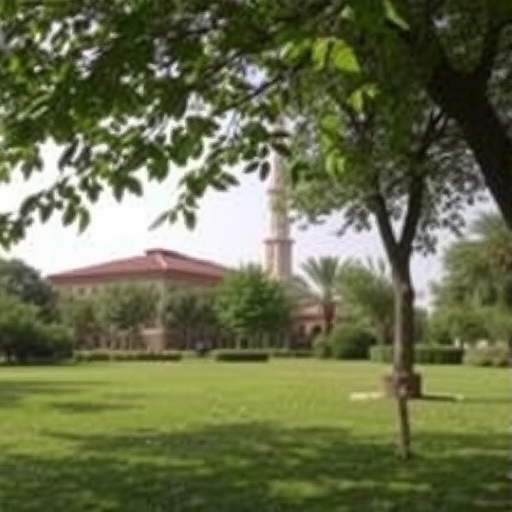In the heart of urban areas, recreational green spaces serve as vital components that contribute significantly to the quality of life for city inhabitants. A comprehensive study centered on Nowshera, Pakistan, has underscored the pressing issue of spatial inequality regarding these cherished city amenities. This assessment, conducted by a team of researchers led by Ibrahim et al., spotlights the challenges and disparities in access to recreational green spaces, ultimately aiming to inform policy and urban planning initiatives.
Urban centers are often characterized by an intricate blend of concrete, steel, and limited greenery. However, as cities continue to expand, the need for recreational spaces that foster well-being and community interaction becomes increasingly critical. The research conducted in Nowshera offers an in-depth examination of these dynamics, analyzing how urban planning and developmental policies shape the accessibility and distribution of green spaces among diverse population segments. The study meticulously maps the existing recreational areas, revealing substantial gaps that necessitate urgent attention.
The significance of recreational green spaces cannot be overstated. They offer numerous benefits that transcend aesthetic value, serving as crucial environments for physical activity, mental health, and social cohesion. In densely populated urban areas like Nowshera, where growth often outpaces infrastructure development, these spaces become even more vital. Yet, this study reveals that many residents face significant obstacles in accessing these essential areas, leading to stark disparities based on socioeconomic status, geographic location, and community resources.
Through detailed spatial analysis and field surveys, the researchers demonstrated how certain neighborhoods are disproportionately deprived of adequate green space. These findings highlight a troubling trend whereby lower-income areas, often inhabited by marginalized populations, are unable to access the same quality and quantity of recreational opportunities as their more affluent counterparts. Such inequities can exacerbate feelings of isolation and hinder overall community well-being, thereby amplifying social and health disparities over time.
Public health experts underscore the importance of proximity to green spaces for promoting physical activity. The Nowshera study aligns with previous research that similarly points to an inverse relationship between socio-economic status and access to these spaces. Communities that lack green recreational areas typically face a higher prevalence of health issues, including obesity and mental health disorders, as residents are deprived of safe environments for exercise and leisure.
Moreover, the configuration of these green spaces plays a crucial role in their utility. The study not only analyzed the quantity of recreational spaces but also their accessibility, usability, and the quality of amenities provided. It became apparent that even when green spaces were available, they often lacked essential features like walking paths, seating areas, or well-maintained gardens, further detracting from their potential benefits. This finding emphasizes the need for a multifaceted approach to urban planning that goes beyond mere quantity, prioritizing quality to enhance community health outcomes effectively.
Ibrahim et al.’s research also establishes a methodological framework that could be applied to other urban areas facing similar challenges. By employing GIS technologies and quantitative spatial measures, the study paves the way for cities worldwide to diagnose their own green space inequalities. This innovative approach showcases how data-driven insights can influence inclusive urban policy that seeks to mitigate disparities.
Local governments and city planners must take heed of these findings and integrate them into comprehensive urban development strategies. By prioritizing equitable access to recreational green spaces, cities can foster healthier, more vibrant communities. The implications of this study echo far beyond Nowshera; they resonate with global urban challenges, where many cities continue grappling with increasing density and commensurate social stratification.
There are promising models around the world showcasing how cities is actively working to enhance green space accessibility. Lessons from cities like Singapore and Vancouver illustrate that strategic planning can yield significant benefits in urban ecology. These examples serve as inspirational touchstones, offering Nowshera and other cities a pathway toward more equitable, green urban narratives.
Additionally, community engagement plays a pivotal role in transforming urban green spaces. Involving residents in the planning and upkeep of these areas can invigorate local ownership and stewardship. Research shows that when communities are engaged, green spaces not only thrive but also reflect the cultural and ecological values of the areas they serve, thereby enhancing community pride and social bonds.
To conclude, the assessment conducted in Nowshera provides a critical lens through which urban planners can view recreational green space access. It serves as a stark reminder of the socio-spatial inequalities that permeate urban landscapes and emphasizes the pressing need for policies that prioritize equitable access to nature. In doing so, we can forge healthier, more resilient urban communities that are truly representative of their residents’ needs and aspirations.
As we examine the future of urban centers worldwide, the integration of ample green spaces will undoubtedly become a litmus test for success in creating livable cities. The findings from Nowshera offer necessary insights as we navigate these complex urban dilemmas and strive for inclusive growth and well-being across diverse populations.
Subject of Research: Spatial inequality and configuration of recreational green spaces in urban centers.
Article Title: Assessment of the spatial inequality and configuration of recreational green spaces in the urban centre of Nowshera, Pakistan.
Article References:
Ibrahim, M., Ahmad, N., Mahar, W.A. et al. Assessment of the spatial inequality and configuration of recreational green spaces in the urban centre of Nowshera, Pakistan.
Discov Cities 2, 113 (2025). https://doi.org/10.1007/s44327-025-00140-9
Image Credits: AI Generated
DOI: https://doi.org/10.1007/s44327-025-00140-9
Keywords: urban planning, green spaces, recreational areas, spatial inequality, public health, community engagement




